Back to Contents Page
Dell™ Latitude™ C600/C500 Series
Service Manual
Exploded View
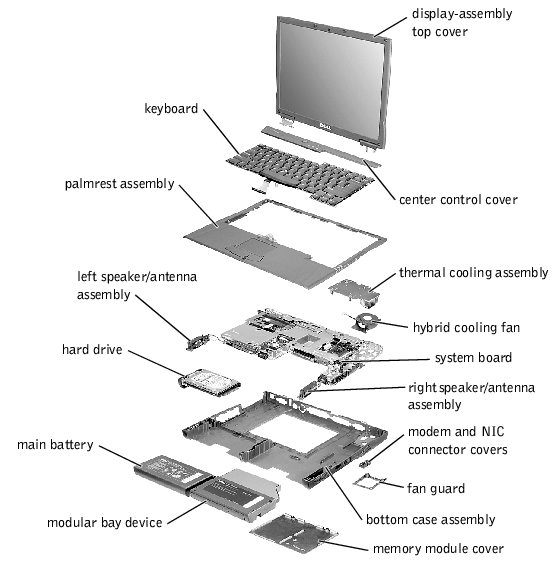
 |
NOTICE: Only a certified service technician should perform repairs on your
system. Damage due to servicing that is not authorized by Dell is not covered
by your warranty.
|
 |
NOTICE: Unless otherwise noted, each procedure in this manual assumes that
a part can be replaced by performing the removal procedure in reverse order.
|
 |
NOTICE: The hard drive is very sensitive to shock. Handle the assembly by its
edges (do not squeeze the top of the hard drive case), and avoid dropping it.
|
Hard Drive
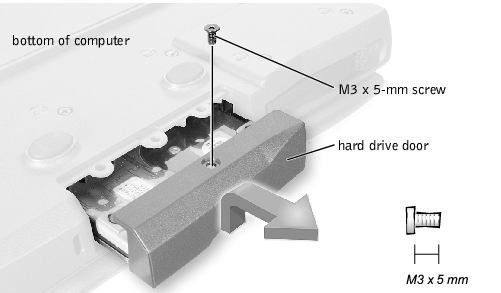
 |
NOTICE: Disconnect the computer and any attached devices from electrical
outlets, and remove any installed batteries.
|
 |
NOTICE: To avoid ESD, ground yourself by using a wrist grounding strap or
by touching an unpainted metal surface on the computer.
|
- Remove the M3 x 5-mm screw from the hard drive door.
- Slide the drive door up until the drive assembly tabs disengage from
the door slots in the bottom case assembly.
- Pull the hard drive straight out of the bottom case assembly.
- Gently push the hard drive into the drive bay until the drive door is
flush with the computer case.
- Push down on the drive door until it snaps into place.
- Replace the M3 x 5-mm screw in the hard drive door.
Memory Module Cover
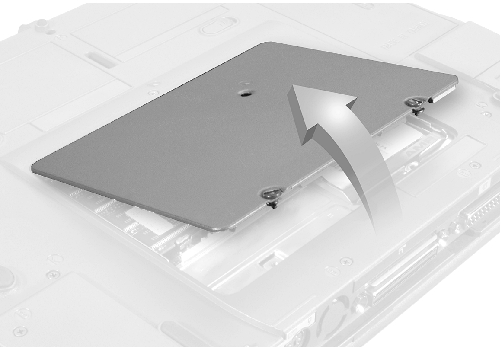
 |
NOTICE: Disconnect the computer and any attached devices from electrical
outlets, and remove any installed batteries.
|
 |
NOTICE: To avoid ESD, ground yourself by using a wrist grounding strap or
by touching an unpainted metal surface on the computer.
|
- Remove the memory module cover:
- Use a coin or flat-blade screwdriver to release the two captive
screws that secure the memory module cover.
- Place your finger under the cover at the indentation and lift and
slide the cover open.
 |
NOTE: The screw labeled with the "circle K" in the middle of the memory
module cover secures the keyboard assembly and does not secure the
memory module cover.
|
Memory Modules
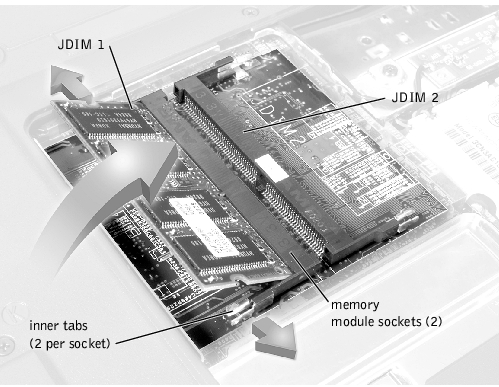
 |
NOTICE: Disconnect the computer and any attached devices from electrical
outlets, and remove any installed batteries.
|
 |
NOTICE: To avoid ESD, ground yourself by using a wrist grounding strap or
by touching an unpainted metal surface on the computer.
|
- Remove the memory module cover.
- To release a memory module from its socket, spread apart the inner
tabs of the memory module socket just far enough for the memory
module to disengage from the socket. The module should pop up
slightly.
- Lift the memory module out of its socket.
- If you only have one memory module, install it in the socket labeled
"JDIM1." Install a second memory module in the socket labeled
"JDIM2."
 |
NOTE: Memory modules are keyed, or designed to fit into their sockets,
in only one direction.
|
 |
NOTICE: The memory module must be inserted at a 45-degree angle to avoid
damaging the connector.
|
- Align the memory module's edge connector with the slot in the center
of the memory module socket. With the module at a 45-degree angle,
press the memory module's edge connector firmly into the memory
module socket.
- Pivot the memory module down until it clicks into place. If you do not
hear a click, remove the memory module and reinstall it.
- Insert the tabs on the memory module cover into the bottom case
assembly. Rotate the memory module cover down and tighten the two
captive screws.
You must remove the optional mini-PCI card assembly before the system
board assembly can be removed. A mini-PCI card assembly may consist of a
modem, a NIC, a modem and NIC combination, or a wireless NIC. A
modem, NIC, or modem and NIC combination must be connected to the
wiring harness as appropriate; a wireless NIC must be connected to the
system's internal antenna.
Mini-PCI Card Assembly Using Interface Cables
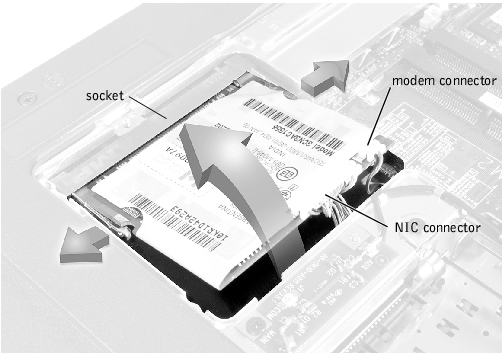
Mini PCI Wireless NIC Assembly Using Antenna Cable
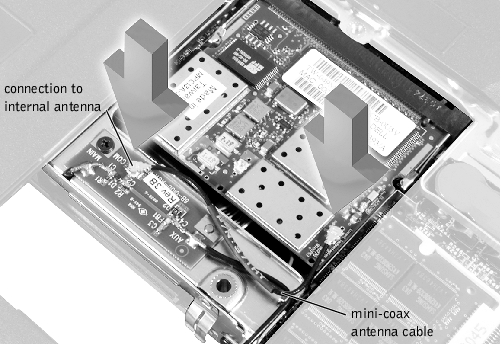
 |
NOTICE: Disconnect the computer and any attached devices from electrical
outlets, and remove any installed batteries.
|
 |
NOTICE: To avoid ESD, ground yourself by using a wrist grounding strap or
by touching an unpainted metal surface on the computer.
|
- Remove the memory module cover.
- To release the mini-PCI card assembly from its socket, spread apart the
metal securing tabs until the assembly pops up slightly.
- Lift the mini-PCI card assembly out of its socket and disconnect any
attached cables.
 |
NOTICE: The mini-PCI card must be inserted at a 45-degree angle to avoid
damaging the connector.
|
 |
NOTICE: The mini-PCI card is keyed, or designed to fit into its socket, in only
one direction. Do not force the connection.
|
- Align the mini-PCI card with the socket at a 45-degree angle, and press
the mini-PCI card firmly into the socket.
- Depending on the type of mini-PCI card you are installing, either
connect the interface cables to the mini-PCI card, or connect the
mini-coax antenna cable from the mini-PCI card to the internal
antenna.
- Lower the mini-PCI card until it snaps into the metal securing tabs.
 |
NOTE: If you are installing a wireless NIC, fold and tuck the unused
interface cables into the slot so they do not interfere with the cover.
|
 |
NOTE: A modem-only mini-PCI card has one connector; place the unused
NIC connector under the mini-PCI card.
|
- Replace the memory module cover.
Removing the Keyboard Screws
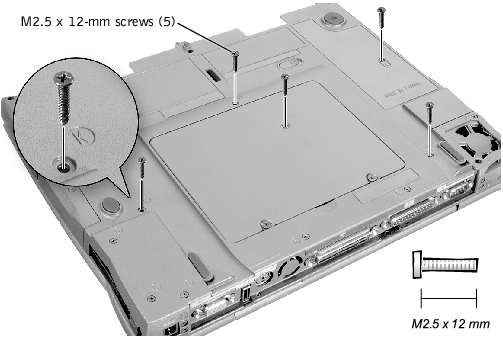
 |
NOTICE: Disconnect the computer and any attached devices from electrical
outlets, and remove any installed batteries.
|
 |
NOTICE: To avoid ESD, ground yourself by using a wrist grounding strap or
by touching an unpainted metal surface on the computer.
|
- Remove the hard drive.
- Turn the computer over, and remove the five M2.5 x 12-mm screws
from the holes labeled "circle K."
- Turn the computer over and open the display.
 |
NOTICE: The key caps on the keyboard are fragile, easily dislodged, and
time-consuming to replace. Be careful when removing and handling the
keyboard.
|
- To release the keyboard from the palmrest assembly, use a small, flat-
blade screwdriver or plastic scribe to pull up on the scalloped edge of
the blank key on the keyboard.
Keyboard
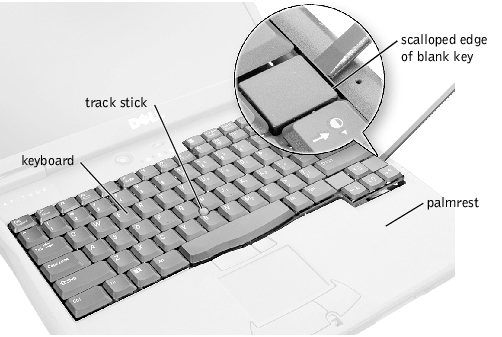
- Lift the keyboard straight up until it clears the keyboard boss support
in the bottom case assembly.
- Rotate the keyboard forward toward the front of the computer.
- Rest the key face of the keyboard on the palmrest.
Keyboard Connector
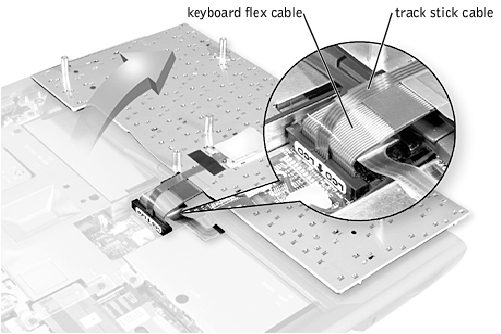
- Disconnect the keyboard flex cable from the interface connector on the
system board assembly by pulling up on the connector.
 |
NOTICE: Do not pull on the keyboard flex cable.
|
- Remove the keyboard assembly from the bottom case assembly.
- Place the keyboard on the palmrest at the front of the computer with
the keys face down and the connector toward the back of the
computer.
 |
NOTICE: To avoid damage to the connector pins, press the keyboard
connector evenly into the interface connector, and do not reverse the keyboard
connector.
|
- Connect the keyboard flex cable to the interface connector on the
system board assembly.
- Carefully turn the keyboard over and fit the keyboard into place.
 |
NOTICE: Position the keyboard flex cable so it is not pinched when you
replace the keyboard in the bottom case assembly.
|
- Check that the keyboard is correctly installed. The keys should be flush
with the left and right surfaces of the palmrest.
- Reinstall the five M2.5 x 12-mm screws in the holes labeled "circle K."
 |
NOTICE: You must remove the display assembly before you remove the
palmrest assembly; the display assembly hinges pass through the back of the
palmrest assembly.
|
 |
NOTE: Always remove and replace the display panel as a complete assembly.
|
 |
NOTICE: Disconnect the computer and any attached devices from electrical
outlets, and remove any installed batteries.
|
 |
NOTICE: To avoid ESD, ground yourself by using a wrist grounding strap or
by touching an unpainted metal surface on the computer.
|
Display Assembly
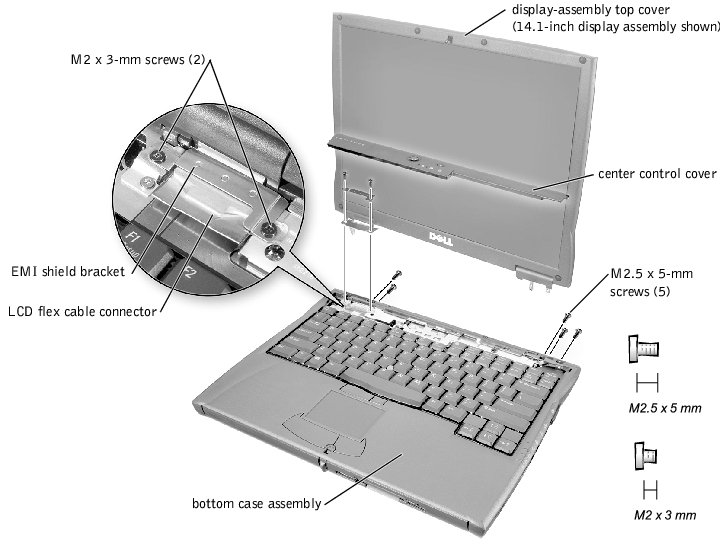
- Remove the hard drive.
- Remove the center control cover.
- Use a scribe to lift the right edge of the center control cover and
pry it loose from the bottom case assembly.
- Lift the center control cover up and away from the bottom case
assembly.
- Close the display.
- From the back of the computer, remove the five M2.5 x 5-mm screws
labeled with the "circle D." There are two screws on the right hinge and
three screws on the left hinge.
- Open the display assembly approximately 180 degrees and support the
display assembly so it does not open past this position.
- Remove the two M2 x 3-mm screws that secure the EMI shield bracket
to the system board assembly.
- Remove the flex cable EMI shield retention bracket that covers the
display-feed flex cable connector on the system board.
- Pull straight up on the display-feed flex cable connector to disconnect
the connector from the system board (see "Display Assembly").
- Lift the display assembly from the bottom case assembly.
 |
NOTICE: When reconnecting the display-feed flex cable connector to the
system board, push down on the top left and right ends of the connector (see
"Reconnecting the Display-Feed Flex Cable Connector"). Pressing on the center
of the connector may damage resistors and compromise EMI protection in the
system.
|
Reconnecting the Display-Feed Flex Cable Connector
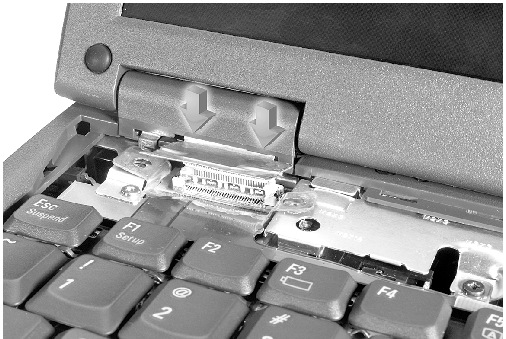
14.1-Inch Display Assembly Bezel and Panel
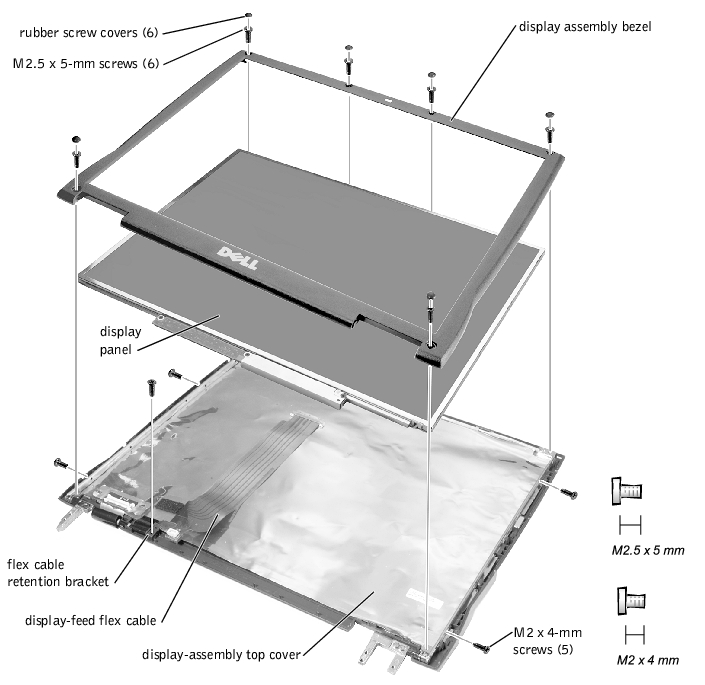
 |
NOTICE: Disconnect the computer and any attached devices from electrical
outlets, and remove any installed batteries.
|
 |
NOTICE: To avoid ESD, ground yourself by using a wrist grounding strap or
by touching an unpainted metal surface on the computer.
|
- Remove the hard drive.
- Remove the display assembly.
- Use the scribe to pry the six rubber screw covers out of the screw holes
located on the bezel on the front of the display assembly.
- Remove the six M2.5 x 5-mm screws located on the bezel on the front
of the display assembly.
 |
NOTICE: To avoid damage to the bezel, do not bend the bezel while
separating it from the display-assembly top cover.
|
- Use a plastic scribe to carefully separate the bezel from the
display-assembly top cover.
 |
NOTICE: Disconnect the computer and any attached devices from electrical
outlets, and remove any installed batteries.
|
 |
NOTICE: To avoid ESD, ground yourself by using a wrist grounding strap or
by touching an unpainted metal surface on the computer.
|
- Remove the hard drive.
- Remove the display assembly.
- Remove the display assembly bezel.
- Remove the hinge covers.
- Remove the two M2 x 4-mm screws on the left side of the display
panel and the two M2 x 4-mm screws on the right side of the display
panel.
 |
NOTE: If you have a Hitachi display panel, remove the two M2 x 4-mm
screws from the center of the left side of the display panel.
|
- Remove the M2 x 4-mm screw that secures the display-feed flex cable
to the display assembly through the black plastic flex cable retention
bracket (see "14.1-Inch Display Assembly Bezel and Panel").
- Disconnect the bottom flex cable connector from the display-assembly
top cover and inverter connector by pulling straight up on the attached
pull tab.
- Lift and rotate the top of the display panel out of the display-assembly
top cover.
- Place the bottom edge of the display panel in the bottom of the
display-assembly top cover and elevate the top of the panel with your
hand.
- Place the display panel in the display-assembly top cover.
- Reinstall the five M2 x 4-mm screws that secure the display panel to
the display-assembly top cover.
Display-Feed Flex Cable
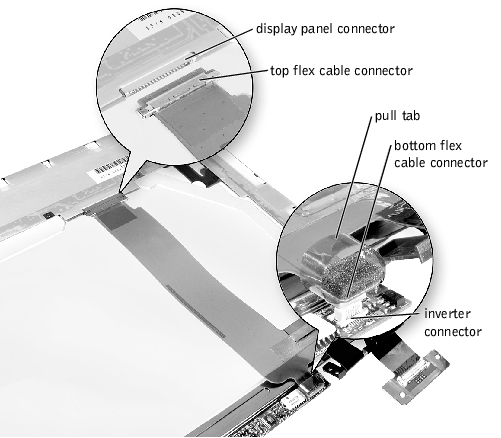
 |
NOTICE: Disconnect the computer and any attached devices from electrical
outlets, and remove any installed batteries.
|
 |
NOTICE: To avoid ESD, ground yourself by using a wrist grounding strap or
by touching an unpainted metal surface on the computer.
|
- Remove the hard drive.
- Remove the display assembly.
- Remove the display assembly bezel.
- Remove the tape that covers the display panel connector.
- Pull the top flex cable connector down and away to remove it from the
display panel connector.
12.1-Inch Display Assembly Bezel and Panel
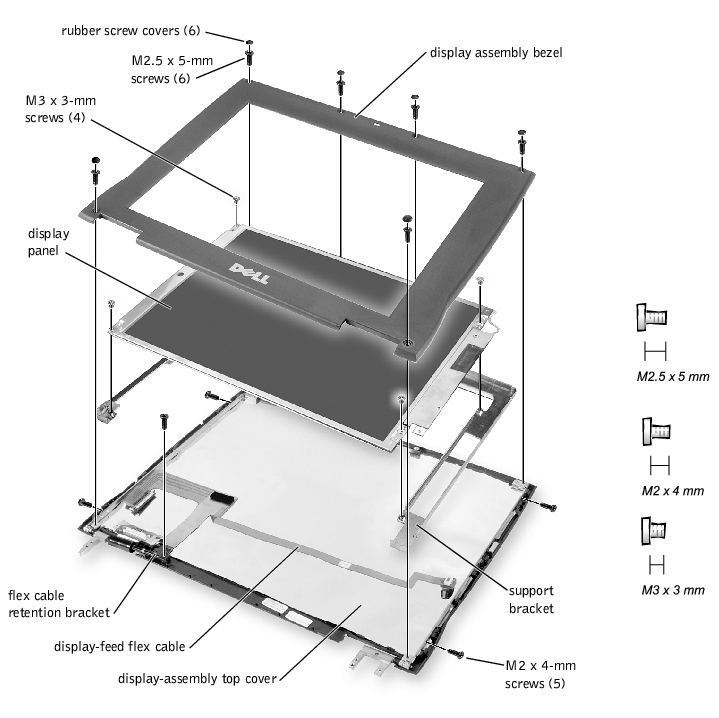
 |
NOTICE: Disconnect the computer and any attached devices from electrical
outlets, and remove any installed batteries.
|
 |
NOTICE: To avoid ESD, ground yourself by using a wrist grounding strap or
by touching an unpainted metal surface on the computer.
|
- Remove the hard drive.
- Remove the display assembly.
- Use the scribe to pry the six rubber screw covers out of the screw holes
located on the bezel on the front of the display assembly.
- Remove the six M2.5 x 5-mm screws located on the bezel on the front
of the display assembly.
 |
NOTICE: To avoid damage to the bezel, do not bend the bezel while
separating it from the display-assembly top cover.
|
- Use a plastic scribe to carefully separate the bezel from the
display-assembly top cover.
 |
NOTICE: Disconnect the computer and any attached devices from electrical
outlets, and remove any installed batteries.
|
 |
NOTICE: To avoid ESD, ground yourself by using a wrist grounding strap or
by touching an unpainted metal surface on the computer.
|
- Remove the hard drive.
- Remove the display assembly.
- Remove the display assembly bezel.
- Remove the hinge covers.
- Remove the four M3 x 3-mm screws on the front of the display panel
that secure the display panel to the support bracket.
- Remove the M2 x 4-mm screw that secures the display-feed flex cable
to the display assembly through the black plastic flex cable retention
bracket (see "12.1-Inch Display Assembly Bezel and Panel").
- Lift up the right side of the display panel, and pull the panel out of the
display-assembly top cover at an angle.
If you are replacing the display-assembly top cover, remove the support
bracket.
- Remove the two M2 x 4-mm screws on the left side of the
display-assembly top cover and the two M2 x 4-mm screws on the right
side of the display-assembly top cover.
- Lift the support bracket out of the display-assembly top cover.
- Place the left edge of the display panel against the left side of the
support bracket in the display-assembly top cover, and elevate the right
side of the panel with your hand.
- Lay the display panel into the display-assembly top cover.
- Reinstall the four M3 x 3-mm screws that secure the display panel to
the support bracket.
Display-Feed Flex Cable
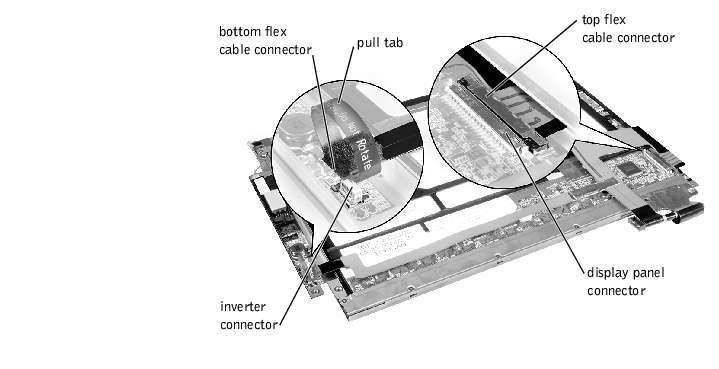
 |
NOTICE: Disconnect the computer and any attached devices from electrical
outlets, and remove any installed batteries.
|
 |
NOTICE: To avoid ESD, ground yourself by using a wrist grounding strap or
by touching an unpainted metal surface on the computer.
|
- Remove the hard drive.
- Remove the display assembly.
- Remove the display assembly bezel.
- Remove the four M3 x 3-mm screws that secure the display panel to
the support bracket (see "12.1-Inch Display Assembly Bezel and
Panel").
- Lift the bottom of the display panel out of the display-assembly top
cover.
- Disconnect the bottom flex cable connector from the inverter
connector by pulling straight up on the attached pull tab.
- Remove the tape that covers the display panel connector.
- Pull the top flex cable connector down and away to remove it from the
display panel connector.
 |
NOTICE: Disconnect the computer and any attached devices from electrical
outlets, and remove any installed batteries.
|
 |
NOTICE: To avoid ESD, ground yourself by using a wrist grounding strap or
by touching an unpainted metal surface on the computer.
|
Display Assembly Latch for 14.1-Inch XGA Display Panels
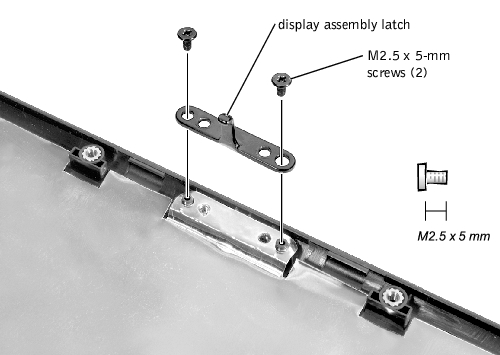
- Remove the hard drive.
- Remove the display assembly.
- Remove the display assembly bezel.
- Remove the display assembly latch by removing the two M2.5 x 5-mm
screws that secure it to the display-assembly top cover.
Display Assembly Latch for 14.1-Inch SXGA+ and 12.1-
Inch Display Panels
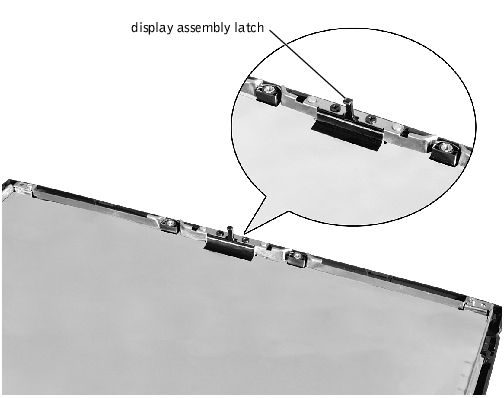
 |
NOTICE: Do not remove the display assembly latch from 14.1-inch SXGA+
and 12.1-inch display panels. If the latch is damaged, replace the
display-assembly top cover.
|
Removing the Hinge Covers
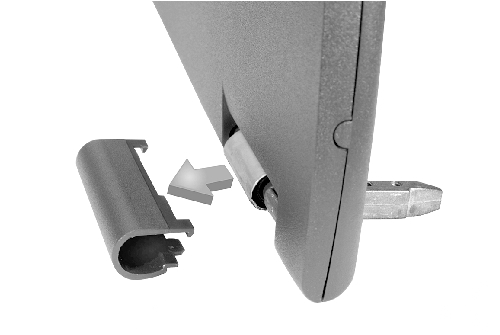
- Remove the display assembly.
- Rotate the hinges forward at an angle of approximately 90 degrees to
the front of the display assembly.
- To remove the hinge covers, slide them off of the hinges.
Hinge Covers
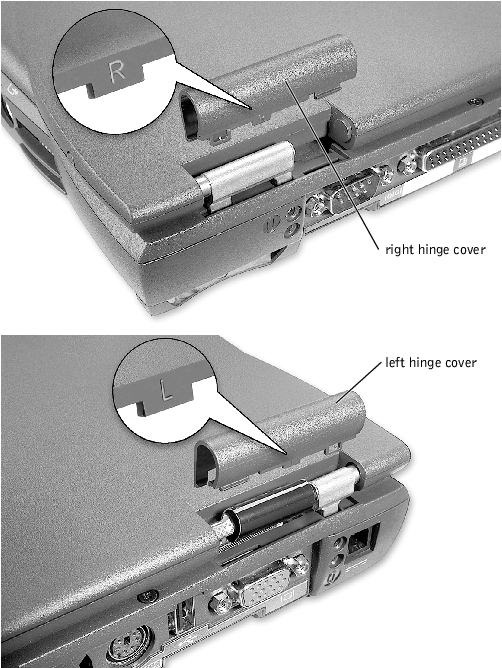
- Attach the display assembly to the bottom case assembly.
- Close the display assembly and snap the hinge covers in place over the
hinges.
 |
NOTE: The right plastic hinge cover label includes an "R," and the left
plastic hinge cover label includes an "L." The hinge cover labels face the
back of the computer.
|
Removing the Palmrest Assembly Screws
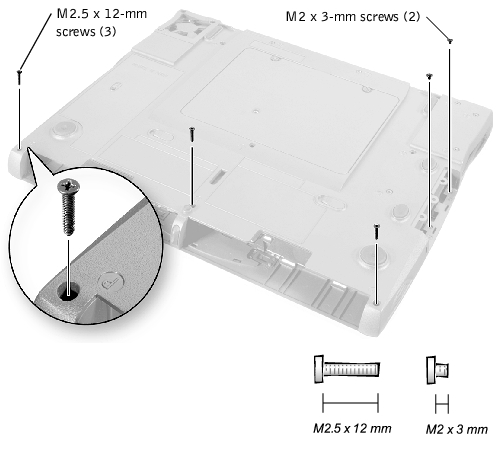
 |
NOTICE: Disconnect the computer and any attached devices from electrical
outlets, and remove any installed batteries.
|
 |
NOTICE: To avoid ESD, ground yourself by using a wrist grounding strap or
by touching an unpainted metal surface on the computer.
|
- Remove the hard drive.
- Remove the keyboard.
 |
NOTICE: You must remove the display assembly before you remove the
palmrest assembly; the display assembly hinges pass through the back of the
palmrest assembly.
|
- Remove the display hinge cover and display assembly.
- Turn the computer over and remove the three M2.5 x 12-mm screws
that are labeled with a "circle P."
- Remove the two M2 x 3-mm screws that are located in the hard drive
bay labeled with a "circle P."
- Turn the computer over, and remove the three M2 x 3-mm screws that
secure the palmrest to the bottom case assembly.
- Remove the two M2 x 3-mm screws that are located on the back
edge of the bottom case assembly, underneath the display
assembly.
- Remove the M2 x 3-mm screw located underneath the keyboard,
on the right side of the bottom case assembly, next to the
microprocessor thermal cooling assembly.
- Pull up on the pull tab that is attached to the palmrest flex cable
connector to remove it from the touch pad connector on the system
board assembly.
Palmrest Assembly
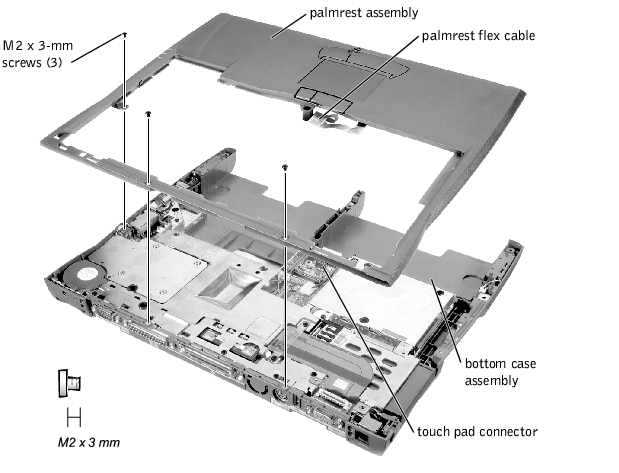
- Using the plastic scribe along the edge of the plastic, remove the
palmrest assembly from the bottom case assembly.
Microprocessor Thermal Cooling Assembly
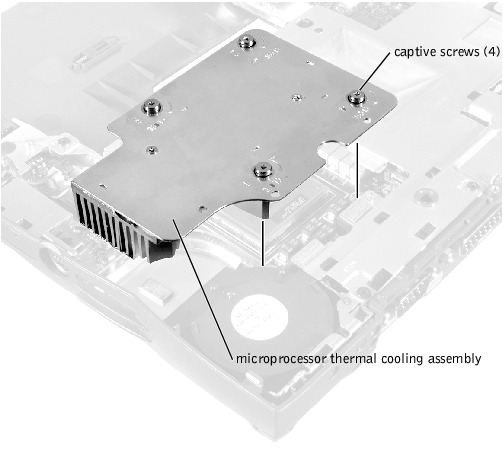
 |
NOTICE: Disconnect the computer and any attached devices from electrical
outlets, and remove any installed batteries.
|
 |
NOTICE: To avoid ESD, ground yourself by using a wrist grounding strap or
by touching an unpainted metal surface on the computer.
|
- Remove the hard drive.
- Remove the keyboard screws.
- Turn the computer over, lift the keyboard up, rotate it forward toward
the front of the computer, and place it face down on the palmrest.
- Loosen the four captive screws securing the microprocessor thermal
cooling assembly.
- Remove the microprocessor thermal cooling assembly from the system
board assembly.
 |
NOTICE: When reattaching the microprocessor thermal cooling assembly,
tighten the captive screws in consecutive order, from 1 to 4.
|
Hybrid Cooling Fan
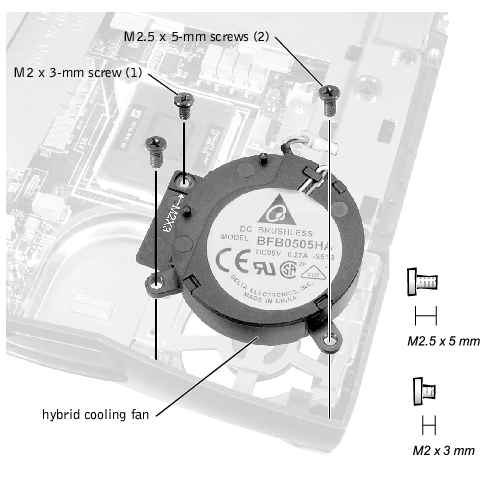
- Remove the hard drive.
- Remove the keyboard assembly.
- Remove the display assembly.
- Remove the palmrest assembly.
- Remove the thermal cooling assembly.
- Remove the two M2.5 x 5-mm screws and one M2 x 3-mm screw that
secure the hybrid cooling fan to the system board.
- Disconnect the fan power cable from the system board interface
connector and remove the hybrid cooling fan.
 |
NOTE: The fan power cable is long, and can be pulled out from under the
EMI shield to provide access to the connector.
|
 |
NOTICE: Do not block the keyboard screw hole when reinserting the fan
cable.
|
Microprocessor Modules
 |
NOTICE: Hold the microprocessor down while turning the cam screw to
prevent intermittent contact between the cam screw and microprocessor.
|
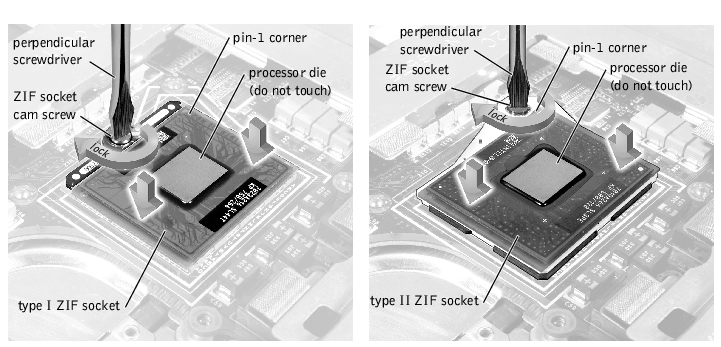
 |
NOTICE: Disconnect the computer and any attached devices from electrical
outlets, and remove any installed batteries.
|
 |
NOTICE: To avoid ESD, ground yourself by using a wrist grounding strap or
by touching an unpainted metal surface on the computer.
|
- Remove the hard drive.
- Remove the keyboard assembly.
 |
NOTICE: To ensure maximum cooling for the microprocessor, do not touch
the heat transfer areas on the thermal cooling assembly. The oils in your skin
reduce the heat transfer capability of the thermal pads.
|
- Remove the microprocessor thermal cooling assembly.
 |
NOTICE: When removing the microprocessor module, pull the module
straight up. Be careful not to bend the pins on the microprocessor module.
|
- Remove the microprocessor module.
 |
NOTICE: To avoid damage to the microprocessor, hold the screwdriver so that
it is perpendicular to the microprocessor when removing the cam screw (see
"Microprocessor Modules").
|
- Use a small flat-head screwdriver and rotate the ZIF socket cam
screw counter-clockwise 180 degrees to loosen the ZIF socket.
The ZIF socket cam screw secures the microprocessor assembly to the system board assembly. Take note of the arrow on the ZIF socket cam screw (see "Microprocessor Modules").
 |
NOTE: Your system has a type I or type II ZIF socket.
|
- Use a microprocessor extraction tool to remove the microprocessor
module.
 |
NOTICE: Seating the microprocessor module properly in the ZIF socket does
not require force.
|
 |
NOTICE: A microprocessor module that is not properly seated can result in
an intermittent connection, or permanent damage to the microprocessor and
ZIF socket.
|
- Align the pin-1 corner of the microprocessor module with the pin-1
corner of the microprocessor socket on the system board and insert the
microprocessor module.
 |
NOTICE: You must position the microprocessor module correctly in the ZIF
socket to avoid permanent damage to the module and the socket.
|
When the microprocessor module is correctly seated, all four corners are aligned to the same height. If one or more corners of the module are higher than the others, the module is not seated correctly.
 |
NOTICE: Hold the microprocessor down while turning the cam screw to
prevent intermittent contact between the cam screw and microprocessor (see
"Microprocessor Modules").
|
- Tighten the ZIF socket by turning the cam screw clockwise to secure
the microprocessor module to the system board assembly.
- Update the BIOS using a flash BIOS update program diskette or CD.
 |
NOTE: For instructions to update or flash the BIOS, see the Dell
Portable Computer BIOS Update Guide.
|
 |
NOTICE: The reserve battery provides power to the computer's RTC and
NVRAM when the computer is turned off. Removing the battery causes the
computer to lose the date and time information as well as all user-specified
parameters in the BIOS. If possible, make a copy of this information before
you remove the reserve battery.
|
 |
NOTICE: Disconnect the computer and any attached devices from electrical
outlets, and remove any installed batteries.
|
 |
NOTICE: To avoid ESD, ground yourself by using a wrist grounding strap or
by touching an unpainted metal surface on the computer.
|
Reserve Battery
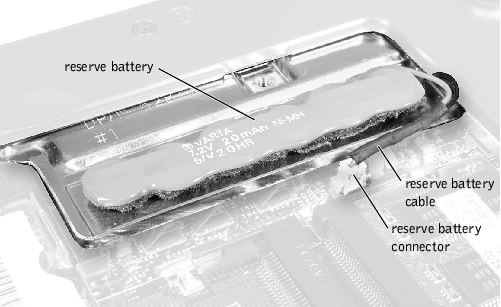
- Remove the hard drive.
- Remove the memory module cover.
- Disconnect the reserve battery cable from the connector on the system
board assembly located next to the reserve battery.
 |
NOTE: If the reserve battery is not located on the EMI shield as shown in
"Reserve Battery," contact Dell technical support.
|
- Remove the reserve battery from the EMI shield:
- Pry the reserve battery free from the foam pad.
- Remove the remnants of the foam pad from the EMI shield.
- Connect the reserve battery cable to the connector on the system
board.
- Position the reserve battery on the EMI shield next to the connector to
minimize slack in the cable.
- Update the BIOS using a flash BIOS update program diskette or CD.
 |
NOTE: For instructions to update or flash the BIOS, see the Dell
Portable Computer BIOS Update Guide.
|
The speakers are located on the front left and right sides of the bottom case
assembly. Each speaker assembly is marked with a right or left label. Take
note of the speaker cable routing in the bottom case assembly so you can
replace it correctly.
Routing the Left Speaker Cable
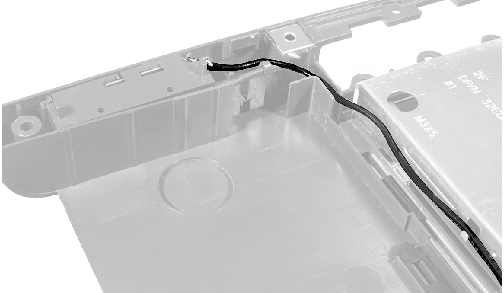
 |
NOTICE: Disconnect the computer and any attached devices from electrical
outlets, and remove any installed batteries.
|
 |
NOTICE: To avoid ESD, ground yourself by touching an unpainted metal
surface or by using a wrist grounding strap.
|
 |
NOTICE: Make note of the speaker and antenna wire routing so you can
replace them properly under their routing clips.
|
Speaker Assemblies
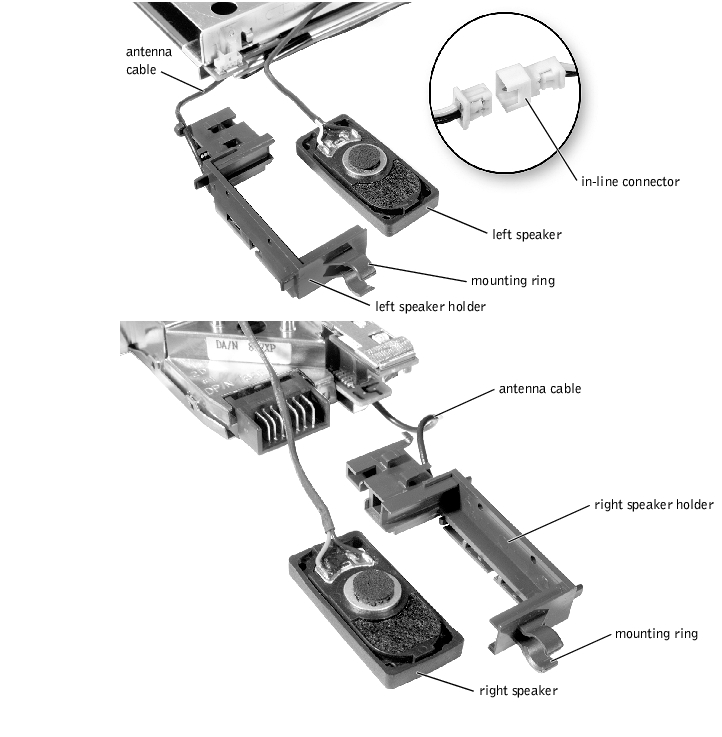
- Remove the hard drive.
- Remove the keyboard assembly.
- Remove the display assembly.
- Remove the palmrest assembly.
- Disconnect the speaker interface cable connectors.
 |
NOTICE: Do not pull the antenna cable when removing the speaker (see
"Speaker Assemblies").
|
- Remove the speaker assemblies by pulling them straight up and out of
the bottom case assembly
 |
NOTICE: Handle the speaker assemblies and speakers with care to avoid
damaging the speaker cones.
|
 |
NOTE: The left speaker has an in-line connector, and its cable is longer
than the right speaker.
|
- To replace the speaker assembly, place the mounting ring over the
front palmrest screw post.
 |
NOTICE: Make sure the speaker wires are under their routing clips. Route the
left speaker wire properly between the battery bay and hard drive area.
|
- Slide the speaker assembly down in to the bottom case assembly.
 |
NOTE: Speakers face out in the bottom case assembly holders.
|
The system board's BIOS chip contains the system's service tag number,
which is also visible on a bar-code label on the bottom of the computer. The
replacement kit for the system board assembly includes a CD that provides
a utility for transferring the service tag number to the replacement system
board assembly.
Removing the System Board Assembly Screws
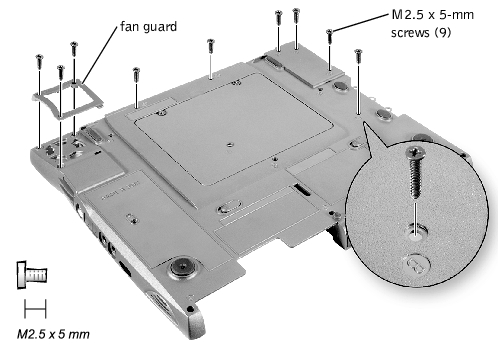
 |
NOTICE: Disconnect the computer and any attached devices from electrical
outlets, and remove any installed batteries.
|
 |
NOTICE: To avoid ESD, ground yourself by using a wrist grounding strap or
by periodically touching an unpainted metal on the computer.
|
- Remove the hard drive.
- Remove the keyboard assembly.
- Remove the display assembly.
- Remove the palmrest assembly.
- Remove the thermal cooling assembly.
- Remove the microprocessor.
- Verify that all PC Cards or plastic blanks are removed from the PC
Card slot.
- Verify that the PC Card ejectors do not extend from the PC Card slot.
- Turn the computer over, and remove the six M2.5 x 5-mm screws
labeled with a "circle B" that secure the system board assembly to the
bottom case assembly.
- Remove the three M2.5 x 5-mm screws labeled with a "circle B" that
secure the fan guard to the bottom case assembly. The fan guard is
located on the right of the bottom case assembly.
System Board Assembly
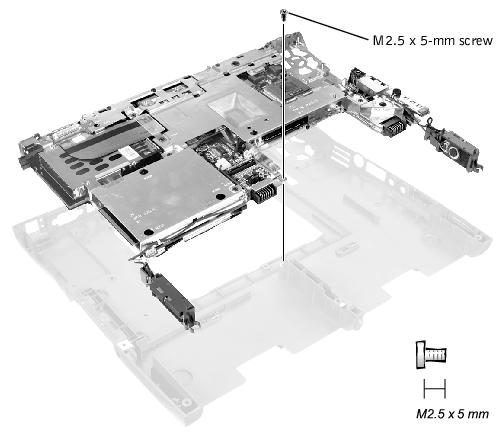
- Turn the bottom case assembly over and remove the M2.5 x 5-mm
screw, which is identified by a white "circle B" and arrow on a red label
attached to the top of the battery connector on the front center of the
system board.
- Remove the speakers from the bottom case assembly.
- Pull the right side of bottom case assembly, next to the external
headphone and microphone connectors, away from the system board
assembly as you simultaneously lift the front of the system board
assembly out and away from the bottom case assembly.
- Install the microprocessor on the replacement system board.
- Connect the right and left speaker to the replacement system board.
- Install the replacement system board.
- Insert the external microphone and headphone connectors
through the plastic bottom case assembly.
- Replace the nine M2.5 x 5-mm screws, starting on the right side of
the bottom case assembly.
- Replace the fan guard cover, inserting the tab into the bottom case
assembly and replace the three M2.5 x 5-mm screws (see "Removing the System Board Assembly Screws"). If you replace the
screw opposite the tab first, it makes it easier to insert and replace
the other two screws.
- Replace the memory modules, mini-PCI card, speaker assemblies, and
the thermal cooling assembly removed from the old system board.
 |
NOTE: Be sure to route cables so that they will not be crimped or pinched
when the complete assembly is put back together.
|
- Replace the palmrest assembly, the display assembly, the keyboard
assembly, and the hard drive.
- Replace the modular bay devices and any PC Cards or plastic blanks in
the PC Card slot.
- Insert the diskette or CD that accompanied the replacement system
board assembly into the appropriate drive, and turn on the computer.
Follow the instructions on the screen.
 |
NOTE: After replacing the system board assembly, be sure to enter the
system's service tag number into the BIOS of the replacement system
board assembly.
|
Battery and Modular Bay Latch Assemblies
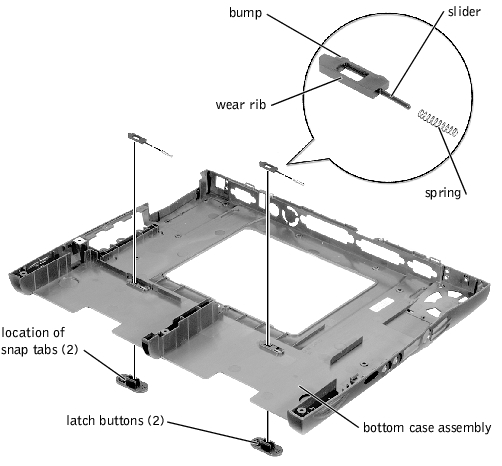
 |
NOTICE: Disconnect the computer and any attached devices from electrical
outlets, and remove any installed batteries.
|
 |
NOTICE: To avoid ESD, ground yourself by using a wrist grounding strap or
by touching an unpainted metal surface on the computer.
|
- Remove the hard drive.
- Remove the keyboard assembly.
- Remove the display assembly.
- Remove the palmrest assembly.
- Remove the system board.
- Remove the battery latch button from the bottom case assembly by
squeezing the snap tabs.
Apply pressure to the latch and spring while unsnapping the snap tabs to prevent the latch assembly from coming loose from the case. If the latch assembly does come loose from the case:
- Reinsert the spring onto the slider on the latch, and reinstall the
module latch into the holding features on the inside of the case.
- Ensure that the slider is inserted in its respective hole, that the
side of the latch with the two bumps is facing the back of the case,
and that the surface with the wear ribs is facing the bottom of the
case.
 |
NOTE: The latch will not function properly if the slider is oriented
incorrectly.
|
- Snap in the new latch button from the bottom of the base, making
certain the snap tabs are fully engaged in the latch.
- Ensure that the newly installed latch moves smoothly and freely when
pushed and released.
- Repeat steps 5 through 7 for the modular bay latch.
Back to Contents Page







































































































































